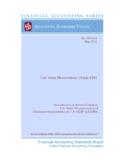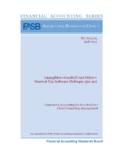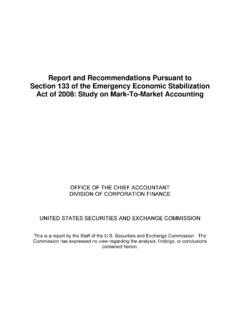Transcription of Fund Accounting Class I - bsasoftware.com
1 Fund Accounting Class I BS&A Fund Accounting Class I i Contents The Accounting Equation and Key Terms to Know .. 1 Assets .. 1 Liabilities .. 1 Fund Equity .. 1 Revenues .. 2 Expenses/Expenditures .. 2 Debit (DR) .. 2 Credit (CR) .. 2 Examples .. 3 Why Use Fund Accounting , and What Is It? .. 5 Fund, Department, and Account Definitions .. 6 Definition of a Fund (FFF) .. 6 Definition of a Department/Activity (DDD) .. 6 Definition of an Account (AAA) .. 6 Types of Funds .. 8 Governmental Fund Category .. 8 Proprietary Fund Category .. 9 Fiduciary Fund Category .. 9 Uniform Chart of Accounts .. 10 What Does a Uniform Chart of Accounts Mean? .. 10 Advantages to Being in Compliance with the Uniform Chart of Accounts.
2 10 How BS&A Can Help You Modify your COA to Comply with the Uniform COA .. 10 Types of Interfund Activity and Sample Entries .. 12 Reimbursements .. 12 Transfers .. 13 Interfund Loans .. 14 Pooled Cash vs. Non-Pooled Cash .. 15 The Internal Control Framework .. 16 BS&A Fund Accounting Class I ii Budgeting .. 17 Getting Audited .. 18 Account Reconciliation .. 20 Common Steps in Performing a Bank Reconciliation .. 20 Things to Look for if Unable to Reconcile the Current Period's Balance .. 21 Useful Websites .. 22 References .. 23 Contacting Us .. 24 BS&A Fund Accounting Class I 1 The Accounting Equation and Key Terms to Know Assets = Liabilities + Fund Equity Assets According to fasb concepts statement no .
3 "Assets are probable future economic benefits obtained or controlled by the particular entity as a result of past transactions or events." Simply anything that you own or have that will provide benefit without having to pay for it again. o Cash o Cash Equivalents o Receivables o Inventories o Prepaid expenses o Capital Assets Liabilities According to fasb concepts statement no . "Liabilities are probable future sacrifices of economic benefits arising from present obligations of a particular entity to transfer assets or provide services to other entities in the future as a result of past transactions or events." Simply money that you owe. It may not be in the form of Cash, but in the form of a service (deferred revenue).
4 O Accounts Payable o Payroll Withholding Payable o Debt Payable Fund Equity Fund Equity is the difference between the Fund's Total Assets and its Total Liabilities. Another way to look at it is the accumulated earnings (losses) or accumulated revenues over (under) expenditures. o Fund Balance o Retained Earnings o Investment in Fixed Assets BS&A Fund Accounting Class I 2 Revenues According to fasb concepts statement no . "Revenues are inflows or other enhancements of assets of an entity or settlement of its liabilities (or a combination of both) during a period from delivering or producing goods, rendering services, or other activities that constitute the entity's ongoing major or central operations.
5 " Simply inflow of assets. o Property taxes o Interest o Charges for services Expenses/Expenditures According to fasb concepts statement no . "Expenses are outflows or other using up of assets or incurrence of liabilities (or a combination of both) from delivering or producing goods, 42 rendering services, or carrying out other activities that constitute the entity's ongoing major or central operations." Simply payment, either in Cash by assuming a liability, or by surrendering an asset. o Salaries o Fringe benefits o Supplies Debit (DR) An Accounting entry that either increases an Asset, or decreases a Liability or Fund Equity. Credit (CR) An Accounting entry that either decreases an Asset, or increases a Liability or Fund Equity.
6 BS&A Fund Accounting Class I 3 Examples Notice how Debits and Credits have an opposite effect depending on the account type. It depends on which side of the Accounting equation the account is. Let's look at these using T-accounts. The left side of a T-account is always the "Debit" side, and the right side is always the "Credit" side. In order for the Accounting equation to remain in balance, Debits must equal Credits. Thus, for every transaction, Debits and Credits must equal not only in total but also for each Fund since each Fund is a set of self-balancing accounts. BS&A Fund Accounting Class I 4 Based on this information, let s use some T-accounts to demonstrate the following transaction: Record bank interest earned on the checking account in the amount of $ 1.
7 Determine which accounts will be used in the transaction. Based on the definition of the account types previously discussed, we'll be using an Asset account and a Revenue account. 2. Cash, an Asset account, has a normal balance of Debit and is therefore increased by a Debit. 3. Interest Revenue, a Revenue account, has a normal balance of Credit and is therefore increased by a Credit. 4. Using the T-accounts for both Cash and Interest Revenue, here is how the transaction would look. Remember that for every Debit there is an equal Credit. BS&A Fund Accounting Class I 5 Why Use Fund Accounting , and What Is It? GASB Cod. sec. gives the rationale for using fund Accounting .
8 It explains ".. the diversity of activities reported by governments and the need to show legal compliance makes it necessary for most governments to use several (and often many) separate funds, each reporting their own assets, liabilities, and equity. For this reason, from an Accounting and reporting standpoint, each government is a combination of a broad variety of funds, each having a separate set of accounts and functioning independently of other funds." Segments of a typical General Ledger Number: FFF-DDD-AAA BS&A Fund Accounting Class I 6 Fund, Department, and Account Definitions Definition of a Fund (FFF) GASB Cod. sec. defines a fund as follows: "..a fiscal and Accounting entity with a self-balancing set of accounts recording cash and other financial resources, together with all related liabilities and residual equities or balances, and changes therein, which are segregated for the purpose of carrying on specific activities or attaining certain objectives in accordance with special regulations, restrictions, or limitations.
9 " o General o Major o Water o Current Tax Definition of a Department/Activity (DDD) A Department/Activity is an office or department to which specific revenues/expenditures are to be allocated. A group of related activities intended to accomplish a major service or regulatory program is a Function, and is covered in Class II. o Clerk o Treasurer o DPW Definition of an Account (AAA) An Account provides a consistent method of identifying the account in which a transaction is to be recorded. o Cash o Interest Revenue o Salary Expense BS&A Fund Accounting Class I 7 This page intentionally left blank BS&A Fund Accounting Class I 8 Types of Funds Governmental Fund Category Most activity for a government is financed and accounted for using this category.
10 O General Fund ..account[s] for all financial resources except those required to be accounted for in another fund. Usually this is the main operating fund for the entity. GASB Cod. sec. limits governments to one general fund. o Special Revenue Funds "..account for the proceeds of specific revenue sources, other than trusts for individuals, private organizations, or other governments or for major capital projects, that are legally restricted to expenditure for specified purposes. Special revenue funds may be used to report a government s restricted own-source revenues, such a hotel room tax, or other restricted revenues, such as grants. Use of special revenue funds is not required unless legally mandated, with one exception: the general fund of a blended component unit must be reported as a special revenue fund.





